Swift Code vs. ABA Number — What's the Difference?
By Tayyaba Rehman — Published on October 23, 2023
Swift Code is an international bank code for money transfers, while ABA Number (or Routing Number) identifies U.S. banks for domestic transactions.

Difference Between Swift Code and ABA Number
Table of Contents
ADVERTISEMENT
Key Differences
Swift Code is a unique identification code that belongs to a specific bank for international money transactions. On the other hand, an ABA Number, also known as a Routing Number, is used to identify specific financial institutions within the United States for domestic transactions.
A Swift Code is typically an 8 or 11 character long alphanumeric code. The structure provides information about the bank's branch and head office. In contrast, an ABA Number is a 9-digit number, designed by the American Bankers Association, primarily to identify banks when processing checks and transferring money between accounts.
When sending money internationally, one would need the receiving bank's Swift Code to ensure the money reaches the correct bank. Conversely, for internal transactions within the U.S., such as direct deposits or bill payments, the ABA Number of the bank is required.
Another differentiation lies in their usage scope. Swift Codes are utilized worldwide, given the nature of international transfers. ABA Numbers, however, are strictly for domestic use within the U.S., making them pertinent only to American financial institutions.
In essence, both Swift Code and ABA Number serve the primary function of identifying banks. However, while Swift Code addresses international banking needs, the ABA Number caters to domestic banking necessities in the U.S.
ADVERTISEMENT
Comparison Chart
Purpose
International money transfers
Domestic transactions in the U.S.
Length and Composition
8 or 11 alphanumeric characters
9-digit number
Origination
International standard
Designed by the American Bankers Association
Usage Scope
Worldwide
United States only
Primary Function
Identify international banks
Identify U.S. banks
Compare with Definitions
Swift Code
An identification for international bank transfers.
To send money to Europe, I needed the bank's Swift Code.
ABA Number
A U.S. bank identification for domestic transactions.
To set up online bill payment, I needed my bank's ABA Number.
Swift Code
An alphanumeric code for global bank identification.
For international wire transfers, the Swift Code is essential.
ABA Number
A domestic bank code used exclusively in the U.S.
Every U.S. bank branch has a unique ABA Number.
Swift Code
An 8 or 11 character code identifying banks globally.
Each branch has its own unique Swift Code for transactions.
ABA Number
A 9-digit code identifying U.S. banks.
I provided my ABA Number for the direct deposit.
Swift Code
The code ensuring money reaches the correct international bank.
She provided her Swift Code so I could wire the funds.
ABA Number
Designed by the American Bankers Association for bank identification.
The check had the bank's ABA Number printed at the bottom.
Swift Code
A global bank code used in international money transactions.
Without the correct Swift Code, the transfer couldn't be processed.
ABA Number
Essential for processing checks and transfers within the U.S.
For internal transfers, the ABA Number is more relevant than the Swift Code.
Common Curiosities
Are Swift Codes and ABA Numbers interchangeable?
No, Swift Codes are for international transactions, while ABA Numbers are for domestic U.S. transactions.
How long is a typical Swift Code?
A Swift Code is either 8 or 11 alphanumeric characters long.
Is the ABA Number used outside the U.S.?
No, ABA Numbers are used exclusively for domestic transactions within the U.S.
Can I find a bank's Swift Code on my check?
Typically, checks display the ABA Number, not the Swift Code. However, banks provide Swift Codes upon request or on their websites.
Do all countries use Swift Codes?
Most countries use Swift Codes for international transactions, but some might have their own systems in place.
Can I use a Swift Code for domestic transactions within the U.S.?
No, for domestic transactions, the ABA Number is used.
Are Swift Codes confidential?
No, Swift Codes are public and often provided on bank websites for customer transactions.
Why do Swift Codes have varying lengths?
An 8-character Swift Code identifies the bank's head office, while an 11-character code specifies a branch.
Who designed the format for ABA Numbers?
The American Bankers Association designed the ABA Number format.
How do I find my bank's ABA Number?
The ABA Number is often found on checks, bank statements, or the bank's website.
Is the Swift Code the same for all branches of a bank?
No, different branches can have different Swift Codes or might use the head office's code.
What does the Swift Code represent?
Swift Code is a unique identification for banks in international money transfers.
Are ABA Numbers unique to each bank branch?
While some banks have unique ABA Numbers for each branch, others use one number for all branches.
Can a U.S. bank have both a Swift Code and an ABA Number?
Yes, U.S. banks involved in international transactions will have a Swift Code, but they'll also have an ABA Number for domestic use.
Is the ABA Number the same as the routing number?
Yes, the ABA Number is also commonly referred to as the routing number.
Share Your Discovery

Previous Comparison
Proximity vs. Vicinity
Next Comparison
Mobile Banking vs. Internet BankingAuthor Spotlight
Written by
Tayyaba RehmanTayyaba Rehman is a distinguished writer, currently serving as a primary contributor to askdifference.com. As a researcher in semantics and etymology, Tayyaba's passion for the complexity of languages and their distinctions has found a perfect home on the platform. Tayyaba delves into the intricacies of language, distinguishing between commonly confused words and phrases, thereby providing clarity for readers worldwide.
















































